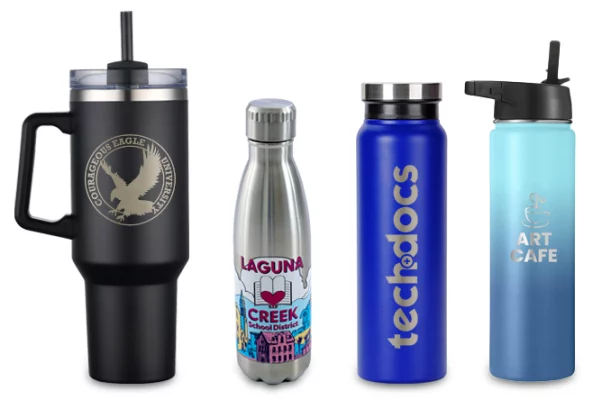Trends & Insights
How to Tell If a Water Bottle Is Stainless Steel?
Simple and Reliable Identification Methods

Why Stainless Steel Verification Matters for B2B Buyers?
For distributors, wholesalers, and promotional product buyers, stainless steel water bottles have become the standard choice for sustainable, durable, and safe drinkware. The global demand for high-quality stainless steel bottles has grown rapidly, and with it, the risk of low-grade or misrepresented products entering the supply chain. For B2B buyers, confirming the authenticity of stainless steel — particularly 304 or 316 grades — is essential to maintaining product quality, compliance with food safety regulations, and brand reputation.
Understanding how to identify genuine stainless steel water bottles before placing large orders can save businesses from costly mistakes. While many buyers rely on visual inspection or brand assurances, combining simple field tests with advanced laboratory methods offers the most reliable verification. This guide by iFun, a professional stainless steel water bottle manufacturer, introduces practical identification methods, common pitfalls to avoid, and best practices for purchasing verified stainless steel drinkware.
1. Basic Physical Identification Methods
1.1 Identification by Color
Color observation is one of the simplest methods to preliminarily assess whether a water bottle is made from stainless steel. After pickling — a process that removes surface oxides and impurities — stainless steel surfaces appear bright, silver-white, and slightly reflective. Chromium-nickel alloys, such as 304 stainless steel, often exhibit a smooth, slightly jade-like sheen, reflecting their higher corrosion resistance. Chromium-only steels, like 430 grade, show a gray metallic tone, while chromium-manganese-nitrogen steels, such as 201 grade, appear lighter but less reflective.
When stainless steel has not undergone pickling or has been exposed to air, its surface color may darken due to oxidation. In such cases, 304 can show a brownish-white hue, 430 may appear brown-black, and 201 appears darker black. While color alone cannot determine the exact grade of stainless steel, it serves as a preliminary check, particularly when combined with other methods. For B2B buyers evaluating samples from suppliers, this simple visual test provides a quick first assessment before investing in further chemical or laboratory testing.
1.2 Magnet Test

The magnet test is a widely used, fast, and non-destructive way to categorize stainless steel. Chromium-only steels, such as 430, are strongly magnetic and will attract a magnet under any condition. Austenitic stainless steels like 304 and 316 are generally non-magnetic in their annealed state, although slight magnetism may appear if the steel has undergone cold working, which can induce martensitic structures. High-manganese steels, including 201, are typically non-magnetic, while some specialized alloys can exhibit mixed magnetic properties depending on their internal microstructure.
While the magnet test cannot provide definitive information about the steel grade, it remains a reliable first step for preliminary inspections. When combined with color observation or chemical tests, it gives buyers a practical and quick method for screening incoming batches and identifying potentially low-quality or misrepresented products.
1.3 Copper Sulfate Test
The copper sulfate test is a chemical method that helps distinguish stainless steel from ordinary carbon or low-alloy steel. To perform this test, first remove any oxide layer from the surface of the water bottle. Apply a small drop of water to the surface and rub it with copper sulfate. If the metal remains unchanged in color, it is usually stainless steel. A purple reaction typically indicates high-manganese steel, while a magnetic metal that changes color likely indicates low-alloy or carbon steel.
This test is simple, portable, and effective for on-site verification, making it particularly useful for B2B buyers conducting quick checks at warehouses or supplier sites. It allows buyers to filter out inferior or fake materials before committing to large orders, reducing supply chain risk and ensuring the authenticity of the products they purchase.
2. Mechanical and Visual Testing in Factory Settings
2.1 Grinding Spark Test

The grinding spark test is a traditional metallurgical technique that provides insights into a stainless steel’s composition. When stainless steel contacts a grinder wheel, sparks are emitted whose patterns reveal information about the metal’s elemental content. High-manganese or manganese-nitrogen steels, such as 201, produce dense, branching sparks with noticeable knots, reflecting their carbon-manganese content. In contrast, chromium and chromium-nickel steels like 304 or 430 generate straighter, less dense sparks without prominent knots.
Although the grinding spark test requires experience to interpret, it is highly useful in factory quality inspections. B2B buyers often rely on this method during sample evaluation or when verifying raw material lots. By combining this method with color and magnet tests, buyers can more accurately identify the material type and screen for potential low-quality or counterfeit products.
3. Advanced Chemical Identification Methods
3.1 Field Reagents and Battery-Free Kits

Chemical reagents provide a more precise way to verify stainless steel composition. Battery-free reagents, often sold as portable kits, can identify elements such as nickel (Ni), molybdenum (Mo), and manganese (Mn) by observing the color change of the solution applied to the metal surface. For example, certain kits indicate 304 stainless steel when the reagent remains colorless or light yellow, whereas lower-grade 201 or 430 steels produce red, purple, or dark reactions.
These kits are practical for B2B buyers who need rapid verification in the field, during sample inspections, or at supplier warehouses. They allow for quick differentiation of authentic 304 or 316 stainless steel from cheaper, misrepresented alloys.
3.2 Battery-Powered Reagents


Battery-powered chemical reagents enable even more precise testing by using small electrochemical currents to determine the percentage of key elements in stainless steel. For instance, an Ni8 reagent can confirm nickel content at approximately 8%, which is characteristic of authentic 304 stainless steel. Yellow or unchanged reactions indicate lower-grade steels such as 201 or 430. Mo2 reagents allow buyers to test molybdenum content, which is essential for identifying 316 stainless steel, known for superior corrosion resistance.
These kits are portable, efficient, and suitable for on-site verification of multiple batches. For B2B buyers purchasing in volume, battery-powered reagents offer a reliable way to ensure the material’s grade and suitability for food-contact applications before committing to large orders.
4. Laboratory and Factory Testing
While physical and chemical methods are effective for field verification, laboratory and factory testing provides the highest level of accuracy. Professional inspections often use X-ray fluorescence (XRF) spectroscopy or spark emission spectrometry to precisely measure chromium, nickel, molybdenum, and other alloying elements. Corrosion resistance tests, such as salt spray exposure, simulate long-term environmental conditions to ensure the material will withstand daily use. Mechanical testing, including hardness and tensile strength, further confirms structural integrity.
For B2B buyers, laboratories and certified OEM factories provide confidence that the stainless steel water bottles they purchase are authentic and safe. Manufacturers like iFun integrate these tests into every production stage, ensuring compliance with FDA, LFGB, SGS, and RCS standards. By combining field and laboratory testing, buyers can significantly reduce the risk of receiving counterfeit or substandard products.
5. Common Misunderstandings in Stainless Steel Identification
Many buyers make assumptions that can lead to mistakes during inspections. For example, some assume that non-magnetic metal always indicates 304 stainless steel, but some 201 alloys are also non-magnetic. Others may think that a shiny surface automatically implies high quality; however, coatings or polish can mask inferior steel. Surface treatments or paint layers can interfere with testing, so it’s crucial to inspect raw, exposed metal. The most reliable approach combines physical observation, magnet testing, chemical reagents, and, if necessary, laboratory verification.
6. How Manufacturers Like iFun Guarantee Authentic Stainless Steel
Professional OEM manufacturers, such as iFun, ensure authenticity through multiple verification steps. All raw materials are certified, and batches undergo magnet, chemical reagent, and spectrometry tests. The production process — from deep drawing to vacuum insulation — is strictly controlled and traceable. B2B buyers partnering with iFun also receive material authenticity documentation and pre-production videos for full transparency, ensuring they can confidently source genuine stainless steel water bottles that meet international food-contact standards.
7. FAQ / Extended Reading
Q1: Is 304 stainless steel food-safe?
Yes, 304 stainless steel is food-grade, corrosion-resistant, and non-toxic, making it safe for drinkware, cookware, and food storage containers.
Q2: Can 304 stainless steel rust?
While 304 stainless steel is highly corrosion-resistant, improper use or exposure to harsh environments can cause minor surface oxidation. Proper care ensures longevity.
Q3: How can I verify the authenticity of stainless steel bottles before bulk purchase?
Buyers can use magnet tests, color observation, copper sulfate tests, and chemical reagent kits. For high assurance, request laboratory verification or work with certified OEM manufacturers.
Q4: What is the difference between 304 and 201 stainless steel?
304 has higher nickel content and superior corrosion resistance, while 201 has more manganese and lower corrosion resistance, often used for budget products.
8. Conclusion
For B2B buyers, ensuring the authenticity of stainless steel water bottles is crucial for maintaining brand reputation, product safety, and customer satisfaction. Combining simple field tests with advanced chemical and laboratory verification provides a reliable, practical strategy for assessing material quality. Partnering with professional OEM manufacturers like iFun guarantees authentic, certified stainless steel bottles, transparent production processes, and consistent quality for every order.


